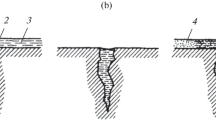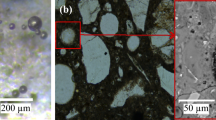Abstract
Scanning electron microscopy (SEM) combined with image analysis can provide a quantitative description of the area distribution of a porous structure, such as a paper coating. This is one of the few techniques where one can limit the measurement area strictly to the coating layer, fully excluding the base paper. It has been found that SEM cross-sectional porosity, defined as visible relative void area, and mercury porosimetry results agreed qualitatively to some degree but differed quantitatively. From an understanding of the differences in observations provided by the two methods, it is realised that comparison of void area distribution and intruded pore volume distribution, the latter including effects of entrance geometry to pores (mercury porosimetry and pore shielding), effectively describes the 2D to 3D transformation between the cross section and the pore network structure, i.e. a description of connectivity, in the unique case where the topology of the pore structure skeleton remains similar. Such structures are termed homeomorphisms. By studying the pore structural parameters of pigmented tablet structures, consisting of natural ground calcium carbonate with progressively increasing dose of latex binder, it is shown that the pore structural parameter of connectivity, and, hence, effective tortuosity/permeability, derived independently using the pore network model, Pore-Cor, can be deduced by forming the differences and correlations (convolution) between the two pore size distribution methods.













Similar content being viewed by others
Notes
Pore-Cor is a software package developed by the Environmental and Fluid Modelling Group, University of Plymouth, PL4 8AA, UK.
Covercarb 75®, Omya AG, Baslerstrasse 42, CH-4665 Oftringen, Switzerland.
Pore-Comp is a software program developed by the Environmental and Fluid Modelling Group, University of Plymouth, PL4 8AA, U.K.
References
Poehler T, Juvonen K, Sneck A (2006) Coating layer microstructure and loacation of binder—results from SEM analysis. In: 9th TAPPI advanced coating fundamentals symposium, Turku. Tappi Press, Atlanta, p 89–100
Ridgway CJ, Gane PAC (2007) J Pulp Pap Sci 33(2):71
Ridgway CJ, Schoelkopf J, Gane PAC (2003) Nord Pulp Pap Res J 18(4):377
Ridgway CJ, Gane PAC (2003) Nord Pulp Pap Res J 18(1):24
Laudone GM, Matthews GP, Gane PAC (2006) J Colloid Interface Sci 304(1):180
Ridgway CJ, Gane PAC, Schoelkopf J (2004) Colloids Surf A 236(1–3):91
Gane PAC, Kettle JP, Matthews GP, Ridgway CJ (1996) Ind Eng Chem Res 35(5):1753
Ridgway CJ, Ridgway K, Matthews GP (1997) J Pharm Pharmacol 49:377
Schoelkopf J, Ridgway CJ, Gane PAC, Matthews GP, Spielmann DC (2000) J Colloid Interface Sci 227(1):119
Matthews GP, Ridgway CJ, Small JS (1996) Mar Petrol Geol 13(5):581
Peat DMW, Matthews GP, Worsfold PJ, Jarvis SC (2000) Eur J Soil Sci 65
Ridgway CJ, Schoelkopf J, Matthews GP, Gane PAC, James PW (2001) J Colloid Interface Sci 239(2):417
Evans M, Hastings N, Peacock B (2000) Statistical distributions. Wiley, New York, p 34
Ridgway CJ, Gane PAC, Schoelkopf J (2006) Transp Porous Med 63(2):239
Darcy H (1856) Les Fontaines Publiques de la Ville de Dijon
Matthews GP, Moss AK, Spearing MC, Voland F (1993) Powder Technol 76:95
Acknowledgement
The authors wish to thank Tiina Pöhler and Eevakaisa Vesanen, KCL, for their skilful sample preparation, SEM measurement and image processing used in this work.
Author information
Authors and Affiliations
Corresponding author
Appendix
Appendix
Complete data for the structures studied (ngcc + latex).
Homeomorphism or topological isomorphism: possessing similarity of form.
From a topological viewpoint two structures are homeomorphic or topologically isomorphic if they are topologically the same. A homeomorphism is, therefore, a continuous stretching and bending of an object into a new shape but retaining the same number of nodes/contact points.
Rights and permissions
About this article
Cite this article
Gane, P.A.C., Salo, M., Kettle, J.P. et al. Comparison of Young-Laplace pore size and microscopic void area distributions in topologically similar structures: a new method for characterising connectivity in pigmented coatings. J Mater Sci 44, 422–432 (2009). https://doi.org/10.1007/s10853-008-3134-8
Received:
Accepted:
Published:
Issue Date:
DOI: https://doi.org/10.1007/s10853-008-3134-8





